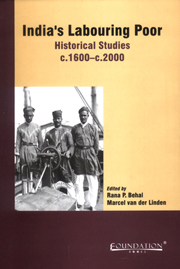Book contents
- Frontmatter
- Contents
- Notes on Contributors
- Frontispiece
- Preface
- Introduction
- Working Across the Seas: Indian Maritime Labourers in India, Britain, and in Between, 1600–1857
- The Brickmakers' Strikes on the Ganges Canal in 1848–1849
- On the Move: Circulating Labour in Pre-Colonial, Colonial, and Post-Colonial India
- Mobility and Containment: The Voyages of South Asian Seamen, c. 1900–1960
- Power Structure, Discipline and Labour in Assam Tea Plantations during Colonial Rule
- “Following Custom”? Representations of Community among Indian Immigrant Labour in the West Indies, 1880–1920
- Masculinity, Respect, and the Tragic: Themes of Proletarian Humor in Contemporary Industrial Delhi
- Stretching Labour Historiography: Pointers from South Asia
- DOCUMENT
- Select Bibliography
Introduction
Published online by Cambridge University Press: 05 January 2012
- Frontmatter
- Contents
- Notes on Contributors
- Frontispiece
- Preface
- Introduction
- Working Across the Seas: Indian Maritime Labourers in India, Britain, and in Between, 1600–1857
- The Brickmakers' Strikes on the Ganges Canal in 1848–1849
- On the Move: Circulating Labour in Pre-Colonial, Colonial, and Post-Colonial India
- Mobility and Containment: The Voyages of South Asian Seamen, c. 1900–1960
- Power Structure, Discipline and Labour in Assam Tea Plantations during Colonial Rule
- “Following Custom”? Representations of Community among Indian Immigrant Labour in the West Indies, 1880–1920
- Masculinity, Respect, and the Tragic: Themes of Proletarian Humor in Contemporary Industrial Delhi
- Stretching Labour Historiography: Pointers from South Asia
- DOCUMENT
- Select Bibliography
Summary
The discussion of labour history in South Asia was first shaped in the early twentieth century by the hands of the members of a very limited intelligentsia who assumed an adversarial role in relation to capital and colonial state power. Many of them happened to be activists and leaders in the organizations and protest movements of the working classes. Their constituents, sections of the labouring poor, were particularly underprivileged in the general context of economic underdevelopment and low per capita GNP in South Asia.
Their structural location in the colonial socio-economic formation was significant too. During the colonial period, the main characteristic of South Asian countries (I have in mind mainly India, Pakistan, Bangladesh, and Sri Lanka) was that capitalist relations were not sufficiently generalized. There was in this respect a qualitative difference from those metropolitan areas of the world which today are called countries of the North. While in the countries of the North in the late nineteenth and twentieth centuries capitalist relations defined and specified the class structure adequately if not always exhaustively, in colonial South Asia, right up to World War II and perhaps even beyond that, pre-capitalist and capitalist organization of economic life coexisted. The resulting stratification or class structure was inchoate, in the process of being formed – and the working class constituted pre-eminently an example of this incomplete transition.
- Type
- Chapter
- Information
- India's Labouring PoorHistorical Studies, 1600-2000, pp. 7 - 20Publisher: Foundation BooksPrint publication year: 2007
- 2
- Cited by

